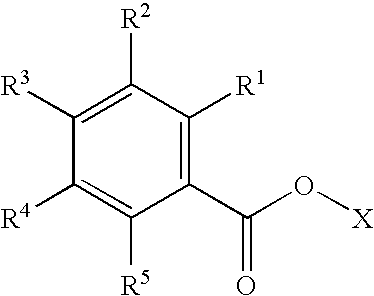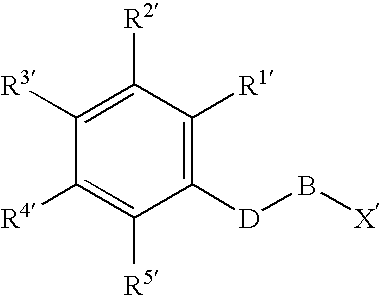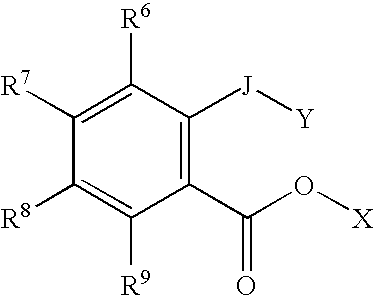Prodrugs activated by targeted catalytic proteins
a technology of catalytic proteins and prodrugs, applied in the direction of peptides, group 5/15 element organic compounds, drug compositions, etc., can solve the problems of cytotoxic cancer chemotherapy agents generally having undesirable toxic effects on normal tissues, limiting the dose of pharmaceutical compounds that can be safely administered, and reducing the potential efficacy, so as to reduce systemic drug toxicity, reduce the toxicity of prodrugs, and minimal drug activation or degradation
- Summary
- Abstract
- Description
- Claims
- Application Information
AI Technical Summary
Benefits of technology
Problems solved by technology
Method used
Image
Examples
example 1a
Preparation of the Prodrugs, Linear Trimethylbenzoyl, Trimethoxybenzoyl-, Trimethoxybenzoyl-, and 5′-O-(2,6-dimethoxybenzoyl)-5-fluorouridine, Compounds 1a, 1b, and 1c
[0747] 5′-O-(2,4,6-Trimethylbenzoyl)-5-fluorouridine 1a. 5′-O-(3,4,5-Trimethoxybenzoyl)-5-fluorouridine 1b and 5′-O-(2,6dimethylbenzoyl)-5-fluorouridine 1c. (For individual reference, compound numbers in bold in the following text refer to the compounds in the synthetic schemes shown in the figures.) Refer to FIGS. 1a and 1c for the bold numbered compounds in this Example.
[0748] The preparation of 5′-O-(2,4,6-trimethylbenzoyl)-5-fluorouridine 1a and 5′-O-(3,4,5-trimethoxybenzoyl)-5-fluorouridine 1b was achieved with the reaction of 2,4,6-trimethylbenzoyl-chloride and 3,4,5-trimethoxybenzoyl chloride with 2′,3′-O-isopropylidene-5-fluorouridine 65 (prepared in Example 16) in pyridine followed by acid hydrolysis with 50% formic acid at 65° C.
[0749] The preparation of 5′-O-(2,6 dimethoxybenzoyl)-5-fluorouridine 1c was a...
example 1b
Preparation of the Hapten for Prodrug 1b in Example 1a, the Linear Phosphonate of Trimethoxybenzoate-5-fluorouridine, Compound 4
[0761] Refer to FIG. 1b for the bold numbered compounds in this Example.
[0762] Uridine was iodinated at the 5 position to give iodide 3a (Robins, J. M., et al., Can. J. Chem. 60 (1982):554-557). The hydroxyl groups were protected to give iodide 3c. 3-Butyne-1-ol was transformed in four steps to alkyne 3d. Alkyne 3d and iodide 3c are coupled using a Pd(II) catalyst to give nucleoside analog 3e (Robins, J. J., et al., J. Org. Chem. 48 (1983):1854-1862). Selective deprotection gives alcohol 3f.
[0763] Dibenzyl 3,4,5-trimethoxyphenylphosphonate 2 can be prepared from the reaction of 3,4,5-trimethoxybromobenzene with dibenzyl phosphite at high temperature in the presence of tetrakis(triphenylphosphine)palladium (0), triethylamine and toluene following the procedure of J. Med. Chem. 32 (1989):1580-1590. Reaction of diester 2 with 1 equivalent of PCl5 gives mono...
example 1c
Preparation of the Hapten for Prodrug 1a in Example 1a, the Linear Phosphonate of Trimethylbenzoate-5-fluorouridine, Compound 4a
[0787] Refer to FIG. 1d for the bold numbered compounds in this Example.
[0788] The intermediate phosphochloridate 2d was prepared starting from bromomesitylene in four steps. Bromomesitylene was treated with n-butyllithium in THF followed by addition of diethylphosphochloridate which afforded phosphonate compound 2b. Compound 2b, on treatment with trimethylsilyl iodide followed by treatment with dilute HCl afforded the corresponding dihydroxy compound 2c. Compound 2c, on treatment with PCl5 in chloroform at 50° C. afforded the phosphochloridate 2d. Compound 3f was coupled with phosphochloridate 2d in methylene chloride in the presence of DMAP to afford coupled compound 3h. Compound 3h was hydrogenated using Pd—C in ethyl acetate to afford the debenzylated compound which on treatment with aqueous ammonia afforded the hapten 4a.
[0789] In detail, the synthe...
PUM
| Property | Measurement | Unit |
|---|---|---|
| pH | aaaaa | aaaaa |
| temperature | aaaaa | aaaaa |
| temperatures | aaaaa | aaaaa |
Abstract
Description
Claims
Application Information
 Login to View More
Login to View More - R&D
- Intellectual Property
- Life Sciences
- Materials
- Tech Scout
- Unparalleled Data Quality
- Higher Quality Content
- 60% Fewer Hallucinations
Browse by: Latest US Patents, China's latest patents, Technical Efficacy Thesaurus, Application Domain, Technology Topic, Popular Technical Reports.
© 2025 PatSnap. All rights reserved.Legal|Privacy policy|Modern Slavery Act Transparency Statement|Sitemap|About US| Contact US: help@patsnap.com



